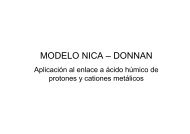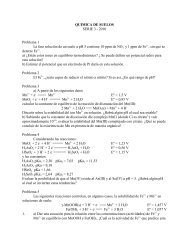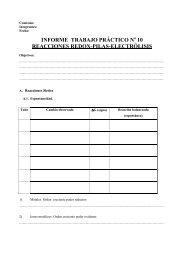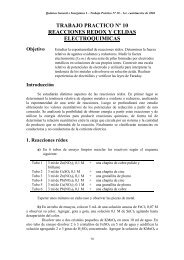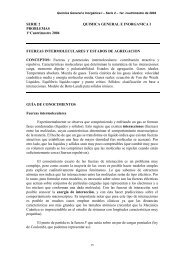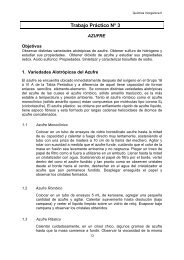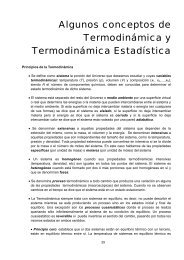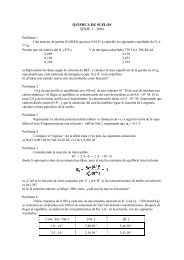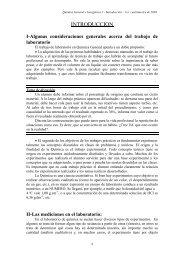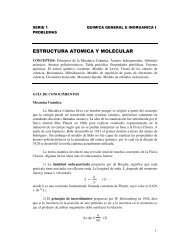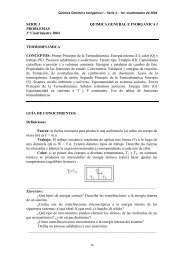Organic acid-induced release of lead from pyromorphite and its ...
Organic acid-induced release of lead from pyromorphite and its ...
Organic acid-induced release of lead from pyromorphite and its ...
Create successful ePaper yourself
Turn your PDF publications into a flip-book with our unique Google optimized e-Paper software.
F. Debela et al. / Chemosphere 80 (2010) 450–456 451stability in the rhizosphere zone (or root-soil interface) where intenseinteractions between PY with roots, soil minerals, microbes,<strong>and</strong> root exudates including low molecular weight organic <strong>acid</strong>s(LMWOA) are expected (Scheckel <strong>and</strong> Ryan, 2002; Zwonitzeret al., 2003; Adriano et al., 2004). Aspergillus niger, an organic-<strong>acid</strong>producing fungus, can dissolve PY while rye grass can take up P<strong>and</strong> Pb <strong>from</strong> PY if it is the sole source <strong>of</strong> P (Sayer et al., 1999). Oxalic<strong>acid</strong> produced by fungi promotes efficient lig<strong>and</strong>-promoted Pbmobilization (Fomina et al., 2004). The concentrations <strong>of</strong> LMWOAin rhizosphere soil are considered to be significantly higher thanin bulk soil solution (Shen et al., 1996; Jones, 1998; Strobel,2001). While Jones (1998) has suggested 10–100 lM soil solutionas a realistic estimate for the concentration <strong>of</strong> most LMWOA inthe rhizosphere soil, other workers have reported as low as 0.9nM oxalic <strong>acid</strong> (Tuason <strong>and</strong> Arocena, 2009) to as high as 4.7 mMcitric <strong>acid</strong> (Dinkelaker et al., 1989). Cao et al. (2002) reported thatcontinuous P consumption by plants may cause decomposition <strong>of</strong>the pre-formed Pb-P minerals. However, there is inadequate researchto demonstrate the long-term stability <strong>of</strong> PY under continuousplant growth. Current knowledge on the fate Pb (<strong>and</strong> P)immobilized as PY in the rhizosphere region is also limited <strong>and</strong>inconclusive.This study was conducted to underst<strong>and</strong> the behavior <strong>of</strong> PY inrhizosphere soils when subjected to various LMWOA commonlyfoundin root-soil interface. In particular, the objective <strong>of</strong> this workwas to compare the <strong>release</strong> <strong>of</strong> Pb (<strong>and</strong> P) <strong>from</strong> synthetic PY in laboratoryconditions when subjected to, acetic, citric, malic <strong>and</strong> oxalic<strong>acid</strong>s at concentrations expected in soils to simulate the fate <strong>of</strong>immobilized Pb (<strong>and</strong> P) in rhizosphere soils. These LMWOAs werejudiciously selected because <strong>of</strong> their ubiquity in soil systems (Ryanet al., 2001; Jones et al., 2003). We discussed the implications <strong>of</strong> Pb(<strong>and</strong> P) <strong>release</strong> with respect to remediation <strong>of</strong> Pb-contaminatedsoils.2. Materials <strong>and</strong> methods2.1. Synthesis <strong>of</strong> <strong>pyromorphite</strong>PY was synthesized under ambient laboratory conditions followingthe method by Scheckel <strong>and</strong> Ryan (2002). PY was obtainedby reacting 0.5 M Pb(NO 3 ) 2 with 0.3 M H 3 PO 4 <strong>and</strong> 0.1 M NaCl solutionin a 4-L beaker. The solution was continuously mixed whilethe phosphoric <strong>acid</strong> was added slowly to the Pb(NO 3 ) 2 <strong>and</strong> NaClsolution. Nitrogen purging to minimize the formation <strong>of</strong> PbCO 3as suggested in the previous method was not necessary here because<strong>lead</strong> carbonate will transform to PY in the presence <strong>of</strong> availablephosphorous (Zhang <strong>and</strong> Ryan, 1999; Melamed et al., 2003).The formation <strong>of</strong> PY was almost instant where a white precipitateformed while the phosphoric <strong>acid</strong> was added. The reaction productwas left to age for 3 d <strong>and</strong> the precipitated PY was collected by centrifugation.The aging process was considered sufficient for the dissolutionreaction as previous work demonstrated that there was nosignificant difference in dissolution pattern between PY aged <strong>from</strong>1 d to 1 year (Scheckel <strong>and</strong> Ryan, 2002). The residual PY was furtherwashed several times with milliQ (mQ) water to remove anyunreacted excess Pb, P, <strong>and</strong> Cl. The final washed product wasfreeze-dried <strong>and</strong> stored in 4 °C until used in the dissolutionexperiments.2.2. Characterization <strong>of</strong> synthetic <strong>pyromorphite</strong>Chemical purity <strong>of</strong> the synthesized PY was determined by elementalanalysis using inductively coupled plasma mass spectroscopy(ICP-MS) after total <strong>acid</strong> microwave digestion procedure.Powder XRD investigation <strong>of</strong> the synthesized PY was conductedusing a Bruker D8 Discover with GADDS system with Co Ka radiationgenerated at 40 kV <strong>and</strong> 20 mA. Integrated EVA s<strong>of</strong>tware(SOCABIM, 2001) was used to calculate major XRD peaks to establishthe mineral identity <strong>of</strong> the synthetic materials. A similar procedurewas applied to the residual materials collected at the end<strong>of</strong> dissolution experiments to underst<strong>and</strong> any crystal alteration <strong>of</strong>PY due to organic <strong>acid</strong>s. The surface morphology <strong>of</strong> synthetic PYbefore <strong>and</strong> after dissolution was studied under a Philips XLS 30Scanning Electron Microscope (SEM).2.3. Batch dissolution <strong>of</strong> <strong>pyromorphite</strong> with organic <strong>acid</strong>sPrior to the dissolution experiments, a 10-d pre-weathering <strong>of</strong>PY was conducted in mQ water to remove ultra fine particles thatmay influence the rates <strong>of</strong> dissolution patterns (Robarge, 1999;Zhang <strong>and</strong> Bloom, 1999). Batch dissolution <strong>of</strong> PY was conductedusing 100 <strong>and</strong> 50 lM <strong>of</strong> acetic, citric, malic <strong>and</strong> oxalic <strong>acid</strong>s for aperiod <strong>of</strong> 1 year. A 50 lM mixed <strong>acid</strong> treatment was also includedto mimic the effects <strong>of</strong> the coexistence <strong>of</strong> these <strong>acid</strong>s in the naturalenvironment <strong>and</strong> dissolution in mQ was used as control. TheLMWOA solutions were prepared in a 0.01 M NaNO 3 solution asbackground electrolyte <strong>and</strong> four drops <strong>of</strong> chlor<strong>of</strong>orm was addedto prevent microbial degradation <strong>of</strong> the organic <strong>acid</strong>s. Initial pHvalues <strong>of</strong> solutions used in the dissolution reaction were:mQ = 5.7, oxalic (100 lM = 3.9, 50 lM = 4.1), citric (100 lM = 4.0,50 lM = 4.4), acetic (100 lM = 4.5, 50 lM = 4.9), malic (100 lM=4.1, 50 lM = 4.5) <strong>and</strong> 50 lM mixed <strong>acid</strong> = 3.6. A major pH changewas not expected between initial <strong>and</strong> final pH <strong>of</strong> the solutions(Scheckel <strong>and</strong> Ryan, 2002).We used <strong>acid</strong> washed 40 mL high-density polyethylene centrifugetubes into which 0.3 g <strong>of</strong> the 10-d pre-weathered PY <strong>and</strong>30 mL <strong>of</strong> mQ or <strong>acid</strong>s were added. The experiment was conductedat ambient room temperature <strong>and</strong> pressure conditions (20 °C <strong>and</strong>101.3 kPa). The tubes were kept in covered boxes to minimizelight, <strong>and</strong> mixtures were gently shaken on a horizontal shaker for2 h weekly (or proportionate periods for short-term dissolutiontimes) <strong>and</strong> just before the end <strong>of</strong> the experiment. At the end <strong>of</strong> eachdissolution period, which ranged <strong>from</strong> 30 min to 1 year, tubes werecentrifuged at high speed (10 4 rpm) for 10 min <strong>and</strong> the clear supernatantwas then carefully filtered using Whatman # 42 filter paper.Supernatant solutions were <strong>acid</strong>ified with 2% HNO 3 <strong>and</strong> stored at4 °C for analysis. Pb <strong>and</strong> P in solution were determined by ICP-MS method. The residual PY at the end <strong>of</strong> the dissolution experimentwas washed five times with mQ water, freeze-dried <strong>and</strong> analyzedusing XRD <strong>and</strong> SEM for any mineral alterations <strong>and</strong>/ormorphological changes.2.4. Statistical analysisStatistical analysis (ANOVA) was conducted to compare the dissolution<strong>of</strong> PY in mQ water <strong>and</strong> LMWOA using the five highest concentrations<strong>of</strong> Pb <strong>and</strong> P in mQ water <strong>and</strong> four <strong>acid</strong>s. These valueswere selected to represent the highest potential for the dissolution(or mobilization) <strong>of</strong> Pb (<strong>and</strong> P) <strong>from</strong> PY by LMWOA at concentrationsused in the experiment.3. Results3.1. Identity <strong>and</strong> morphology <strong>of</strong> synthetic <strong>pyromorphite</strong>Lead <strong>and</strong> P contents showed stoichiometric ratio (Pb:P) <strong>of</strong> 1.67<strong>and</strong> confirmed the chemical purity <strong>of</strong> the synthesized PY. Scanningelectron micrographs <strong>and</strong> X-ray diffractograms revealed that syntheticmaterial was mono-mineralic PY with small (0.5–1.0 lm)tabular <strong>and</strong> columnar morphology that tends to aggregate into a




